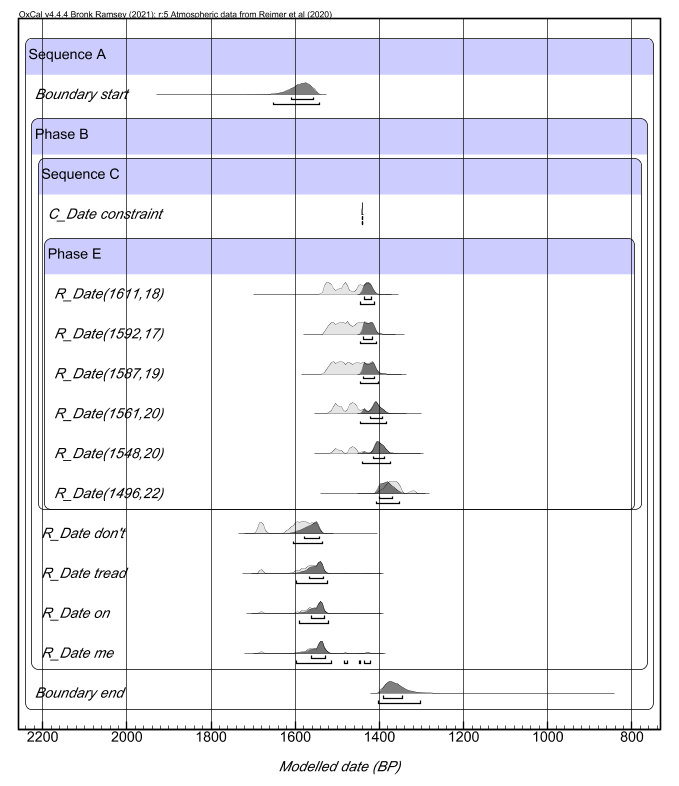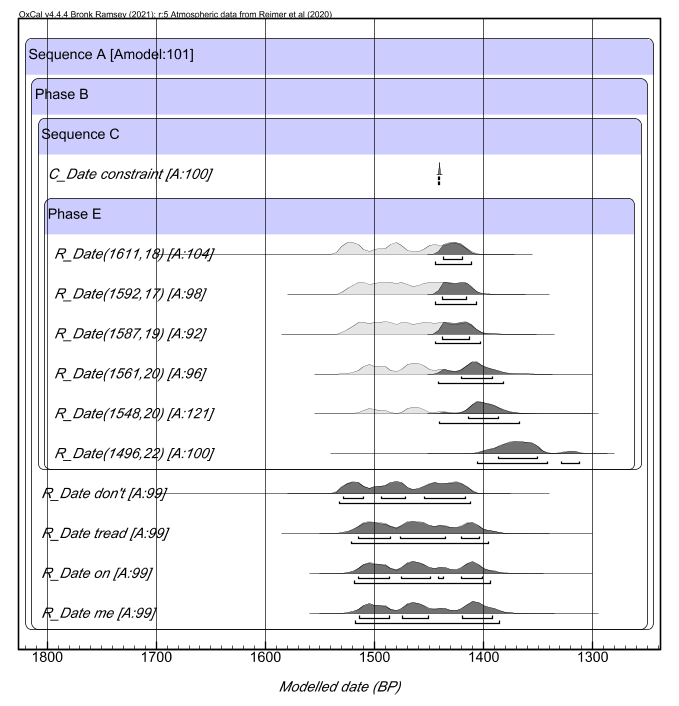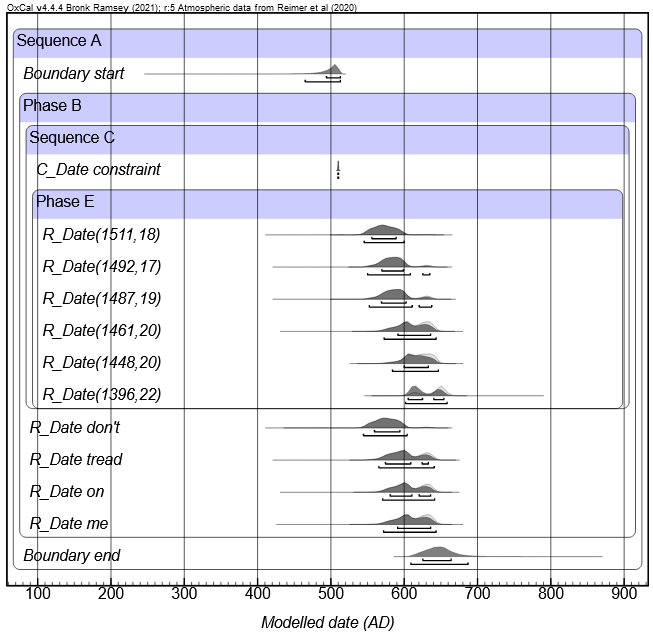After constraint and Sequence
t...@tsdye.online
{
Boundary("start");
Phase("B")
{
Sequence("C")
{
After("D")
{
C_Date("constraint", 510, 0);
};
Phase("E")
{
R_Date(1611, 18);
R_Date(1592, 17);
R_Date(1587, 19);
R_Date(1561, 20);
R_Date(1548, 20);
R_Date(1496, 22);
};
};
R_Date("don't", 1606, 20);
R_Date("tread", 1572, 22);
R_Date("on", 1567, 19);
R_Date("me", 1561, 21);
};
Boundary("end");
};
Richard Staff

Research Fellow in Quaternary Geochronology
Scottish Universities Environmental Research Centre (SUERC)
University of Glasgow
Tel.: +44 (0)1355 270198
Sent: 29 June 2022 20:27
To: OxCal <ox...@googlegroups.com>
Subject: After constraint and Sequence
You received this message because you are subscribed to the Google Groups "OxCal" group.
To unsubscribe from this group and stop receiving emails from it, send an email to oxcal+un...@googlegroups.com.
To view this discussion on the web visit https://groups.google.com/d/msgid/oxcal/d308878c-c4f1-4d44-aa07-103728ef9b06n%40googlegroups.com.
t...@tsdye.online
Richard Staff

Research Fellow in Quaternary Geochronology
Scottish Universities Environmental Research Centre (SUERC)
University of Glasgow
Tel.: +44 (0)1355 270198
To: OxCal <ox...@googlegroups.com>
Subject: Re: After constraint and Sequence
t...@tsdye.online
Richard Staff

Research Fellow in Quaternary Geochronology
Scottish Universities Environmental Research Centre (SUERC)
University of Glasgow
Tel.: +44 (0)1355 270198
MILLARD, ANDREW R.
Hi Tom,
I think your original model was correct, and I would not make Richard’s change. The After indicates that everything stratigraphically later than this sample dates after it, but it has no known chronological relationship to stratigraphically earlier events. In your model, the only earlier event is the Boundary Start. However, Constraint can indirectly affect Start and the Phase D dates as it modifies the distributions for samples in Phase E, and these are used in calculating Start. This is what you were seeing initially. Your model is saying that a priori you do not know how Start is related to Constraint.
If I run your model with all the C14 dates shifted 100 years later, it is clear that Start is not required to be earlier than Constraint.
 .
.
In the model without After, Start is forced to predate Constraint. I suspect this is not what you want your model to do.

Best wishes
Andrew
--
Dr. Andrew Millard
Associate Professor of Archaeology,
Durham University, UK
Email: A.R.M...@durham.ac.uk
Personal page: https://www.dur.ac.uk/directory/profile/?id=160
Scottish Soldiers Project: https://www.dur.ac.uk/scottishsoldiers
Dunbar 1650 MOOC: https://www.futurelearn.com/courses/battle-of-dunbar-1650
From: ox...@googlegroups.com <ox...@googlegroups.com>
On Behalf Of Richard Staff
Sent: 30 June 2022 08:51
To: ox...@googlegroups.com
Subject: Re: After constraint and Sequence
[EXTERNAL EMAIL]
To view this discussion on the web visit https://groups.google.com/d/msgid/oxcal/LO2P265MB276611A2F81038698C44FDB6AFBA9%40LO2P265MB2766.GBRP265.PROD.OUTLOOK.COM.
Richard Staff
Sent: 30 June 2022 10:48
To: ox...@googlegroups.com <ox...@googlegroups.com>
Subject: RE: After constraint and Sequence
